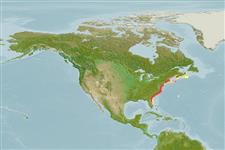>
Eupercaria/misc (Various families in series Eupercaria) >
Sciaenidae (Drums or croakers)
Etymology: Cynoscion: Greek, kyon = dog + Greek, odous = teeth + Greek, skion, skiaina = barbel, red mullet (Ref. 45335).
More on authors: Bloch & Schneider.
Environment: milieu / climate zone / depth range / distribution range
экология
морской; солоноватоводный демерсальный; мигрирует в океане (Ref. 51243); пределы глубины 10 - 26 m (Ref. 54407). Subtropical; 17°C - 27°C (Ref. 54461); 47°N - 27°N, 82°W - 59°W
Western Atlantic: Nova Scotia, Canada to northern Florida, USA. Introduced in Europe (Ref. 122657).
Length at first maturity / Size / Вес / Возраст
Maturity: Lm 17.9, range 14 - 22.5 cm
Max length : 98.0 cm TL самец/пол неопределен; (Ref. 40637); common length : 50.0 cm TL самец/пол неопределен; (Ref. 3702); наибольший вес (опубликованные данные): 8.9 kg (Ref. 40637)
колючие лучи спинного плавника (общее число) : 11; членистые (мягкие) лучи спинного плавника (общее число) : 25 - 29; колючие лучи анального плавника: 2; членистые (мягкие) лучи анального плавника: 11 - 13. Body greenish grey above and silvery below, back with small spots forming undulating dotted lines. Pelvic fins and anal fin yellowish other fins pale, sometimes with a yellowish tinge. Inside of opercle dark, visible externally. Mouth large, oblique, lower jaw projecting. Upper jaw with a pair of large canine-like teeth at tip. Chin without barbels or pores. Snout with only 1 marginal pore. Gas bladder with a pair of nearly straight, horn-like appendages. Soft portion of dorsal fin covered with small scales up to 1/2 of fin height (Ref 51721).
Occurs usually in shallow coastal waters over sand and sandy mud bottoms. Juveniles are euryhaline. During summer the fish move to their nursery and feeding grounds in river estuaries. Feeds mainly on crustaceans and fishes. Oviparous, with high fecundity (Ref. 54406). The species leave estuaries during the fall when water temperatures decrease, but are also known to overwinter in these areas. It has been reported that the fish cease feeding and die when the water temperature reaches 7.9 deg C and 3.3 deg. C, respectively (Ref. 122657). Utilized fresh and frozen; eaten steamed, pan-fried, broiled, microwaved and baked (Ref. 9988).
Robins, C.R. and G.C. Ray, 1986. A field guide to Atlantic coast fishes of North America. Houghton Mifflin Company, Boston, U.S.A. 354 p. (Ref. 7251)
Статус Красного Списка МСОП (Ref. 130435: Version 2024-1)
Угроза для людей
Harmless
Использование человеком
рыболовство: коммерческий; объект спортивного рыболовства: да; аквариум: общественные аквариумы
дополнительная информация
инструменты
Специальные отчеты
Скачать в формате XML
ресурсы в Интернет
Estimates based on models
Preferred temperature (Ref.
123201): 7.2 - 24.9, mean 12.7 °C (based on 172 cells).
Phylogenetic diversity index (Ref.
82804): PD
50 = 0.5000 [Uniqueness, from 0.5 = low to 2.0 = high].
Bayesian length-weight: a=0.00759 (0.00662 - 0.00869), b=3.06 (3.04 - 3.08), in cm total length, based on LWR estimates for this species (Ref.
93245).
Trophic level (Ref.
69278): 3.8 ±0.2 se; based on diet studies.
устойчивость к внешним воздействиям (Ref.
120179): средний (среднего размера), минимальное время удвоения популяции 1.4-4.4 года (K=0.26-0.3; Fec = 45,000).
Prior r = 0.30, 95% CL = 0.20 - 0.46, Based on 1 full stock assessment.
Fishing Vulnerability (Ref.
59153): Moderate to high vulnerability (45 of 100).
Climate Vulnerability (Ref.
125649): High vulnerability (58 of 100).
Nutrients (Ref.
124155): Calcium = 57.1 [32.9, 114.6] mg/100g; Iron = 0.985 [0.510, 1.744] mg/100g; Protein = 19.1 [17.6, 20.8] %; Omega3 = 0.286 [0.169, 0.468] g/100g; Selenium = 23 [12, 48] μg/100g; VitaminA = 11.8 [3.9, 41.6] μg/100g; Zinc = 0.635 [0.458, 0.956] mg/100g (wet weight); based on
nutrient studies.
